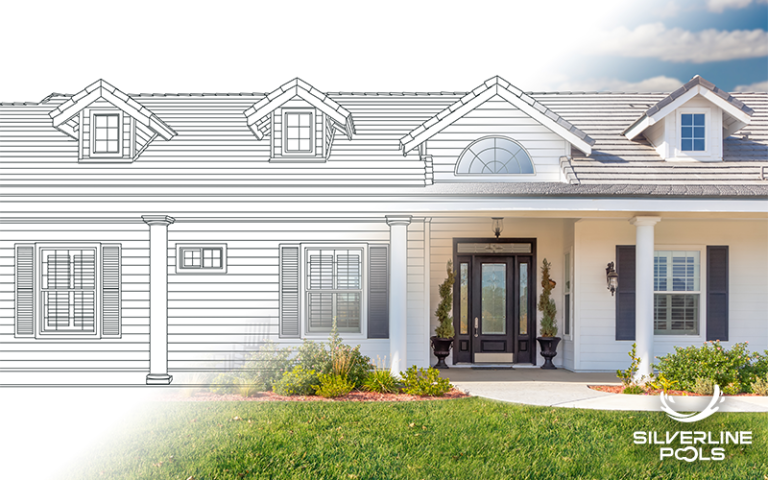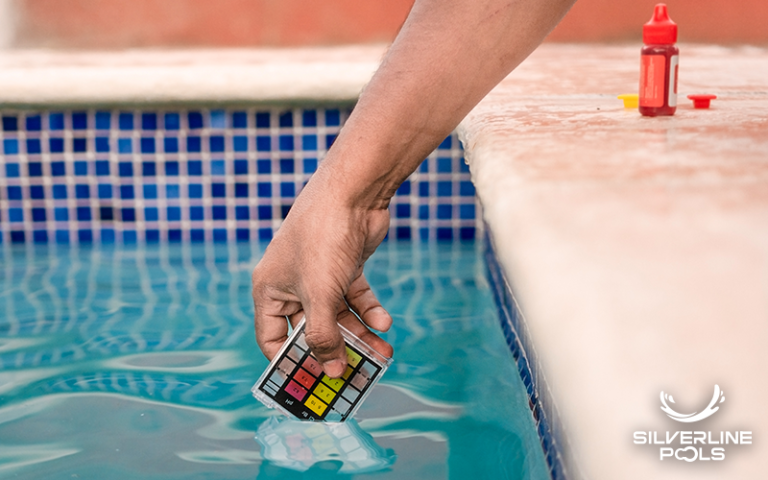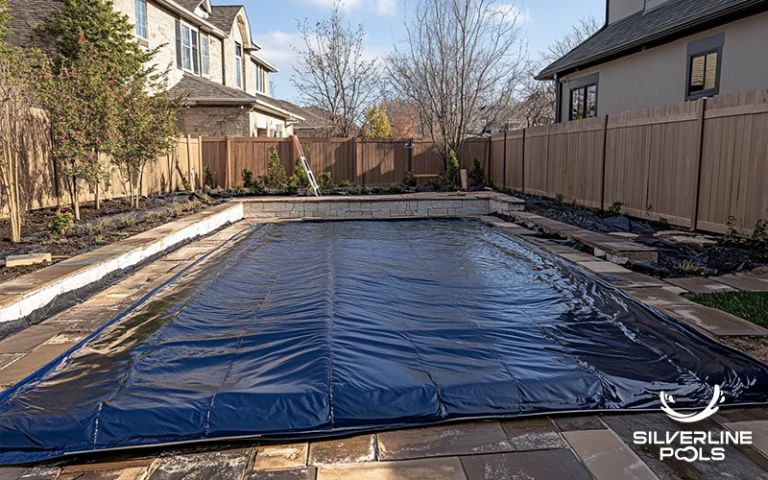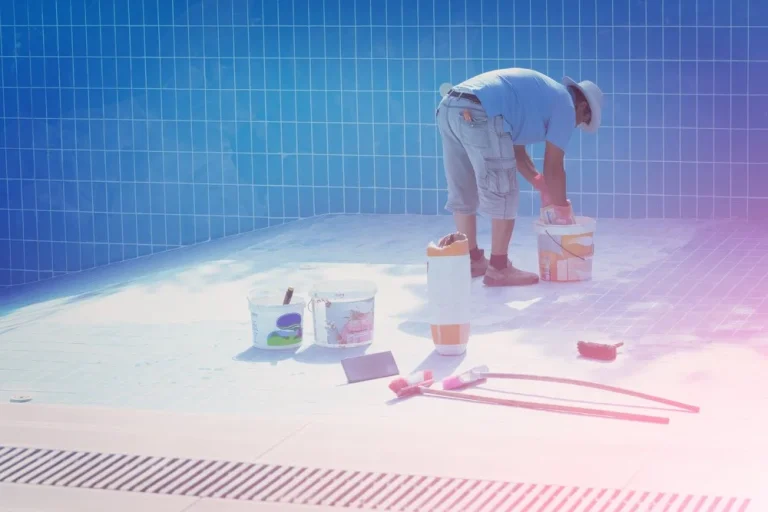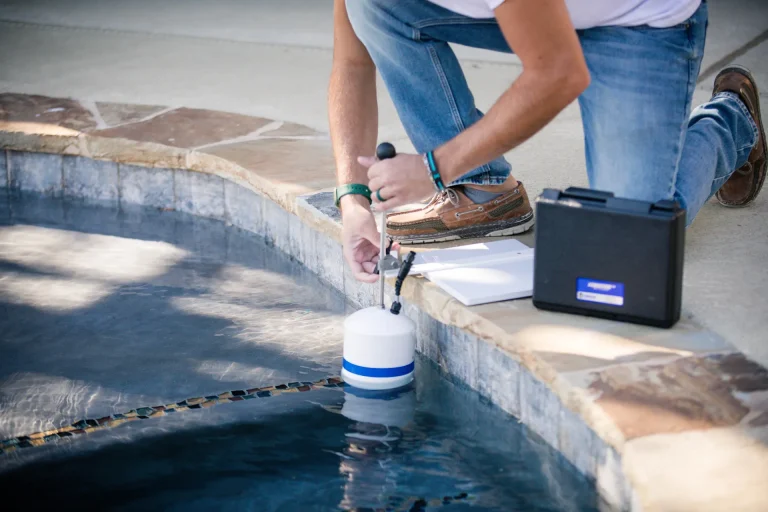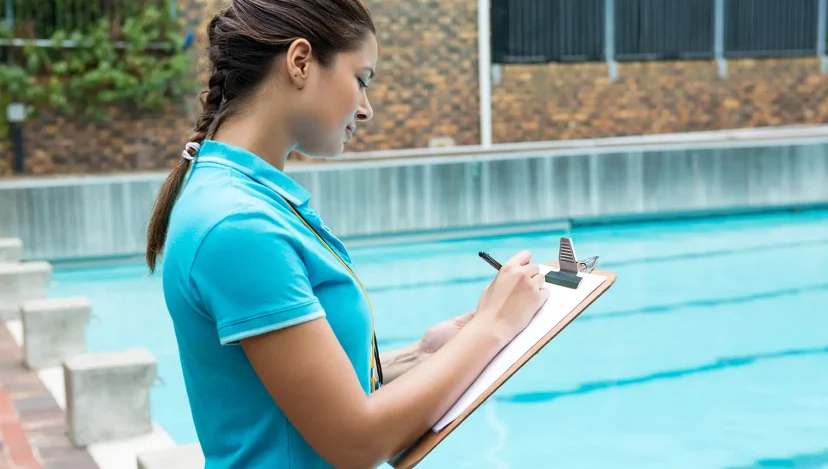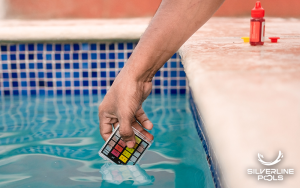Have you ever checked the alkalinity of your pool water in your daily pool maintenance and cleaning routine? If not, you are missing a key aspect of pool cleaning. Balanced pool alkalinity maintains the pool’s pH level.
This blog covers everything you need to know about total alkalinity in your pool. It explores the reasons, effects, and solutions for low or high pool alkalinity. In this accessible guide, pool owners will find ways to test their DIY pool alkalinity with the outlined safety precautions.
Let’s jump into the details.
What is alkalinity/total alkalinity in a pool water?
Pool alkalinity, or total pool alkalinity, refers to bicarbonates and hydroxides (alkaline substances) in pool water that are used to maintain the right pool pH level. These substances neutralize pool acids and bases and are measured as parts per million (ppm) equal to one milligram per liter of water.
Why is it necessary to balance pool alkalinity?
Balanced pool alkalinity is necessary for uninterrupted and healthy pool swimming. Maintaining pool chemicals, pH, and alkalinity results in clean water and benefits the pool structure. Here are some of the benefits of balanced pool alkalinity:
- It helps in maintaining a stable pool pH.
- It ensures swimmers’ comfort and safety.
- Prolongs the life of pool structure and pool equipment.
- It increases the effectiveness of pool shock treatment.
How do I test for pool alkalinity?
The two ways to test your pool’s alkalinity are:
1. Test Strips
Test strips are an easier and quicker way to check for pool alkalinity. Here is what to do while using test strips for alkalinity check.
- Dip the strips for a few seconds in your pool water.
- Take out the strip and hold it horizontally for about 15 seconds.
- Finally, compare the color of the total alkalinity pad on the strip to the color code on the container.
2. Liquid Testing Kits
Liquid testing kits provide more accurate alkalinity data compared to test strips. Here is how to do it:
- Take a water sample from your pool through the tube provided with the kit.
- Follow the instructions on the kit, and add chemicals to the water sample.
- The substances will change the sample color.
- Compare the sample water’s new color with the kit’s color chart.
Safety tips when balancing alkalinity in swimming pools
Follow the below necessary guidelines for the safe balancing of pool alkalinity:
- Always wear rubber gloves, footwear, protective eyewear, and long clothing while handling the pool chemicals.
- Do not add water to chemicals; always add chemicals to water.
- Never, ever mix two chemicals.
- Do not let the kids and pets near the pool chemicals.
- Do not breathe directly into the pool chemicals.
- Always read the instructions labeled on the chemicals’ pack carefully.
How can I raise my pool’s alkalinity level?
Sodium bicarbonate, or baking soda, is an alkalinity increaser that effectively raise your pool’s alkalinity level. Adding the right baking soda can bring your pool’s alkalinity level back to a normal range.
Follow the given steps to do it effectively:
- Test your pool water alkalinity level through a pool testing kit or a pH sensor. If it is below 80 ppm, the pool water likely needs a baking soda solution.
- Add baking soda according to the pool size or the instructions provided on the chemical pack. The recommended range is 1.5 pounds of sodium bicarbonate per 10,000 gallons of water.
- Retest the pool water alkalinity level and add more baking soda if needed.
How can I lower my pool’s alkalinity level?
The question is how to treat high alkalinity in the pool. Generally, acidic compounds and pH reducers act as pool alkalinity accelerators. Here is a guideline to lower your high alkalinity in the pool:
- Check and test the alkalinity level of your pool.
- Add sodium bisulfate or muriatic acid to a bucket according to your pool’s needs. Read the proper instructions provided on the chemical pack.
- Add the solution to different areas of the pool.
- Keep running your pool pump for at least 5 to 6 hours.
- Recheck the pool alkalinity after 24 hours.
What is low pool alkalinity?
Low pool alkalinity is when the concentration of alkaline substances falls below 80–120 ppm. This condition needs immediate attention.
What causes low pool alkalinity?
The following are the reasons responsible for low alkalinity in a pool:
- Excessive urine and perspiration levels in the pool water.
- Heavy rainfall.
- Using excessive chlorine tablets for pool sanitation.
- Use of too much dry acid.
- Backwashing or draining pool water.
What are the effects of low pool alkalinity?
Here are the impacts of the low pool alkalinity:
- Frequent falls in pH.
- Complaints about burning eyes and skin irritation.
- The pool water may turn a greenish hue.
- Stained pool finishing.
- Pool metal corrosion.
- Ineffective pool chlorine.
What is high pool alkalinity?
The situation when the concentration of dissolved alkaline substances exceeds the desired level of between 80 and 120 ppm is called high pool alkalinity.
What are the reasons for high pool alkalinity?
High alkalinity in a pool is caused mainly by:
- Accumulation of calcium carbonate due to evaporation.
- Lotions, sun creams, sweat, and body residues.
- Contact with carbonate rock.
- Incorrect use of chemical products.
- Malfunctions in the pool filtering system.
What are the effects of high pool alkalinity?
Here are the adverse effects of high pool alkalinity:
- Calcium buildup on the pool’s surface
- It can increase the pool pH, which may require too much effort to bring down
- Pool equipment staining and corrosion
- It may result in cloudy pool water
- It may also irritate the skin and eyes
- Reduced pool circulation due to a clogged filter
- Rough pool surfaces
What is the difference between pool pH and alkalinity?
The table below shows the difference between pool pH and alkalinity in the pool.
| Pool pH | Pool Alkalinity |
| It defines how acidic or basic the pool water is. | It shows the dissolved alkaline substances in the pool, especially carbonates and bicarbonates. |
| It is measured on a scale of 0 to 14. | It is measured in parts per million (ppm) |
| Seven is neutral on the pH scale. Below seven shows acidic pool water. Above 7 indicates a primary pool of water. | It acts as a buffer to resist pH imbalances. |
| The ideal pool pH range is between 7.6 and 7.8. | The ideal pool alkalinity range is between 80 and 120 ppm. |
Silverline Pools: Your Best Pool Maintenance Company
Silverline Pools is your first choice for pool maintenance. Our personalized pool maintenance and cleaning services are available for various pool sizes, conditions, and budgets. Whether balancing your pool water chemistry or maintaining proper water alkalinity, our expert team is always ready to serve. Here is what is included in our pool maintenance package:
- Regular, biweekly, weekly, monthly, or seasonal pool cleaning and care.
- Checking and balancing pool pH, chemicals, and alkalinity.
- Maintaining and cleaning your pool equipment.
- Post-storm pool cleanup.
- Green pool treatments
- Pool shock treatment
Final Thoughts
Balancing pool alkalinity and other pool chemicals is crucial for swimmers’ health and pool equipment. Urination, heavy rains, body lotions, malfunctioning filters, and other factors can disturb the balanced level of alkaline substances in a pool.
While pool alkalinity balancing is a DIY project, hiring the services of an expert company will do it more safely and efficiently. Silverline Pools is the best company to maintain your pool chemical balances. Contact their expert team and enjoy worry-free and healthy swimming through the summer.
Frequently Asked Questions
What is the ideal pool alkalinity range?
The recommended total alkalinity level for a pool ranges from 80 to 120 ppm.
Will shocking pools lower alkalinity?
Shocking the pool doesn’t lower the pool’s alkalinity. It primarily increases chlorine levels and kills pool algae or bacteria.
What should I adjust first, alkalinity or pH?
We recommend maintaining your pool alkalinity level before adjusting your pool pH.
How long does it take for the alkalinity to adjust in the pool?
The time taken for pool alkalinity adjustment depends on the amount of baking soda added, water circulation, and initial alkalinity level. However, the chemicals take at least six hours to adjust.
How to raise alkalinity without raising pH?
Adding baking soda (sodium bicarbonate) to your pool water is the most effective way to raise alkalinity without affecting the pH level.

